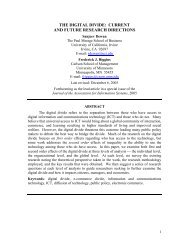When Should Software Firms Commercialize New Products ... - MISRC
When Should Software Firms Commercialize New Products ... - MISRC
When Should Software Firms Commercialize New Products ... - MISRC
You also want an ePaper? Increase the reach of your titles
YUMPU automatically turns print PDFs into web optimized ePapers that Google loves.
sides, the firm profits more overall due to cross-side positive network effects. This literature<br />
largely focuses on pricing strategies for distinct but complementary products/markets, with<br />
significant interests in identifying the “money” side (Rochet and Tirole 2003, 2006, Parker<br />
and Van Alstyne 2005).<br />
A common assumption of all the above reviewed models is that customers have full<br />
information regarding the value of each product version, and they self-select into purchase<br />
groups according to the menus of price and quality offered by the vendors. Essentially,<br />
these models assume a pre-existing first period when customers were allowed to test fully<br />
functional versions prior to market release, followed by a second period when the versioned<br />
product is commercialized. While this stream of literature advances the theory behind<br />
optimal versioning, it does not explore in the first place whether or not the firm should fully<br />
inform customers with respect to product value prior to market release. Moreover, most of<br />
these models (with the exception of Raghunathan 2000, who presents a two-period model<br />
without network externalities) consider one-period frameworks, abstracting from adoption<br />
dynamics over time. In that sense, network effects are captured at the utility level (if at<br />
all) as usage benefits, ignoring community-induced consumer valuation learning over time<br />
via word of mouth. By employing a two-period framework with word-of-mouth effects to<br />
inspect how valuation learning and imperfect information on the consumer side affect the<br />
FLF offering and its performance relative to perfect information approaches such as TLF,<br />
we bring a significant contribution to the existing literature on software versioning.<br />
The second stream of literature relevant to our work is related to product sampling<br />
and free demonstration. These well studied marketing strategies are particularly appealing<br />
to digital goods, many of which are experience goods whose value is learnt by customers via<br />
tryingthegooditselforaversionofit(ChellappaandShivendu2005). Inpractice, freemium<br />
models do capitalize on this important characteristic of digital goods. While under TLF<br />
consumers gain full access to the software functionality through a free trial for a limited<br />
period of time and learn the true value of each feature, under FLF, they only adjust their<br />
priors on the value of premium features based on experiencing basic features but may not<br />
reach the true value. Therefore, in digital goods markets, net of advertising, word of mouth<br />
effects, or direct network effects, firms can influence individual consumers’ product value<br />
expectations by controlling the degree and type of free consumption. Thus, when comparing<br />
strategies side by side, the firm must account for the impact of its chosen business model<br />
6
















